Quality Management in Health and Social Care: Stretton Nursing Home
VerifiedAdded on 2023/02/02
|15
|4552
|30
Report
AI Summary
This report provides a comprehensive analysis of quality management within the health and social care sector, specifically using Stretton Nursing Home as a case study. It begins by exploring the perspectives of various stakeholders on quality, including service users, CQC, and service providers, examining their expectations and concerns. The report then analyzes the roles of external agencies like CQC and NMC in setting and enforcing quality standards. It assesses the detrimental impact of poor service quality on stakeholders, including service users, government, and staff. The report further delves into existing standards, such as those set by CQC and NICE, and evaluates different approaches to implementing quality systems, with a recommendation for the Total Quality Management (TQM) model. Finally, it identifies and analyzes potential barriers to delivering quality care, such as poor management, lack of training, and communication issues, providing insights into how these challenges can be addressed to improve the quality of service delivery within the health and social care sector.
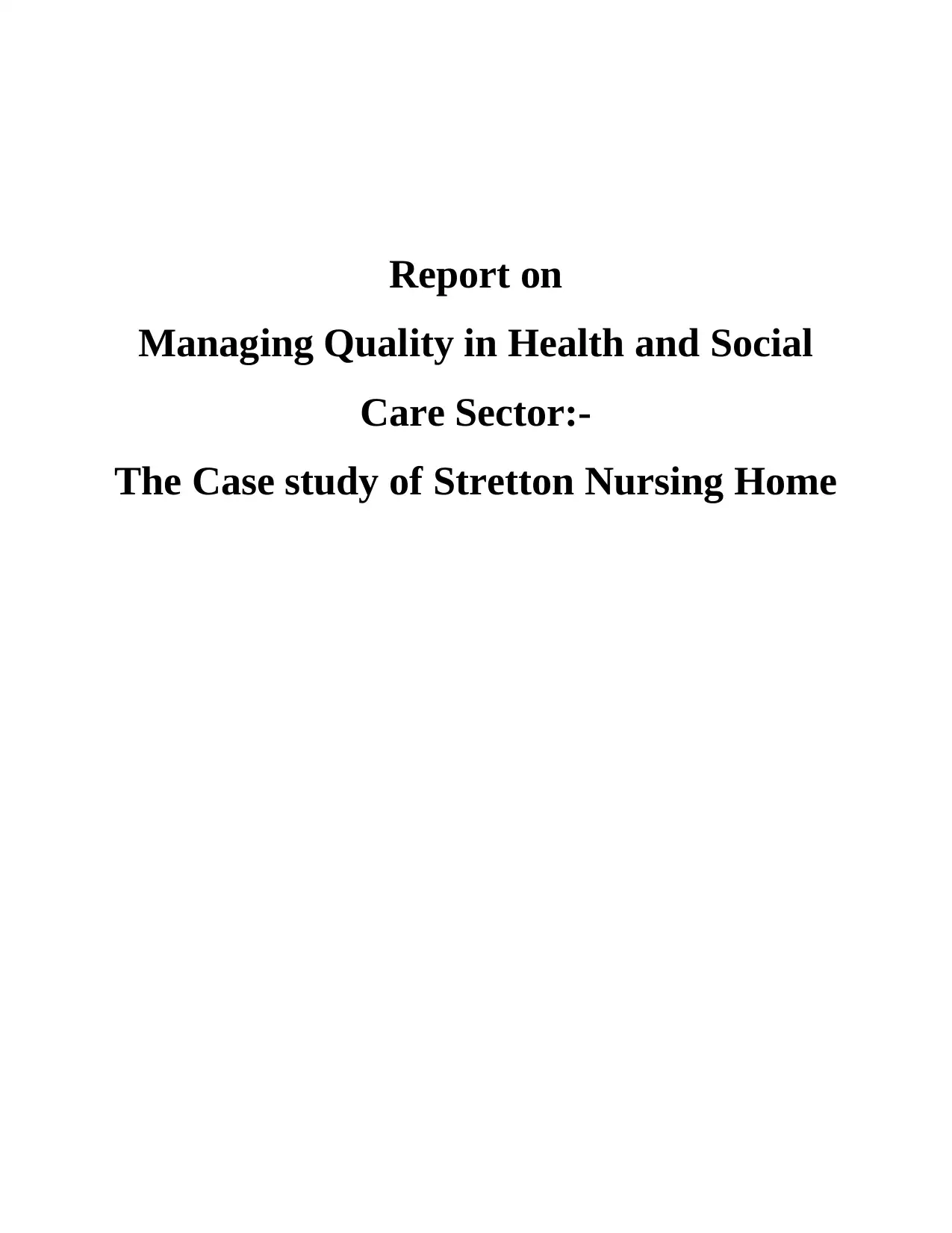
Report on
Managing Quality in Health and Social
Care Sector:-
The Case study of Stretton Nursing Home
Managing Quality in Health and Social
Care Sector:-
The Case study of Stretton Nursing Home
Paraphrase This Document
Need a fresh take? Get an instant paraphrase of this document with our AI Paraphraser
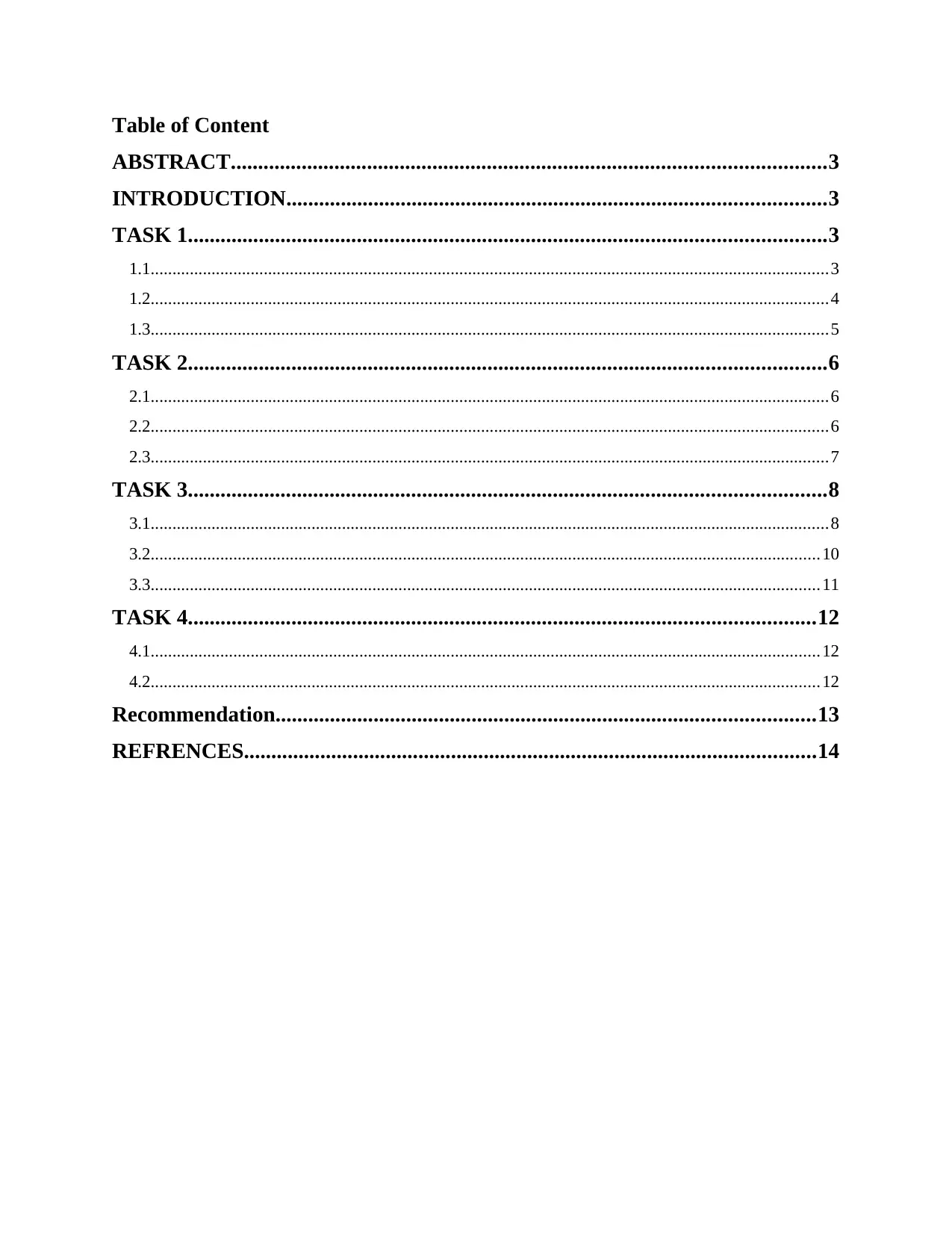
Table of Content
ABSTRACT.............................................................................................................3
INTRODUCTION...................................................................................................3
TASK 1.....................................................................................................................3
1.1............................................................................................................................................................3
1.2............................................................................................................................................................4
1.3............................................................................................................................................................5
TASK 2.....................................................................................................................6
2.1............................................................................................................................................................6
2.2............................................................................................................................................................6
2.3............................................................................................................................................................7
TASK 3.....................................................................................................................8
3.1............................................................................................................................................................8
3.2..........................................................................................................................................................10
3.3..........................................................................................................................................................11
TASK 4...................................................................................................................12
4.1..........................................................................................................................................................12
4.2..........................................................................................................................................................12
Recommendation...................................................................................................13
REFRENCES.........................................................................................................14
ABSTRACT.............................................................................................................3
INTRODUCTION...................................................................................................3
TASK 1.....................................................................................................................3
1.1............................................................................................................................................................3
1.2............................................................................................................................................................4
1.3............................................................................................................................................................5
TASK 2.....................................................................................................................6
2.1............................................................................................................................................................6
2.2............................................................................................................................................................6
2.3............................................................................................................................................................7
TASK 3.....................................................................................................................8
3.1............................................................................................................................................................8
3.2..........................................................................................................................................................10
3.3..........................................................................................................................................................11
TASK 4...................................................................................................................12
4.1..........................................................................................................................................................12
4.2..........................................................................................................................................................12
Recommendation...................................................................................................13
REFRENCES.........................................................................................................14
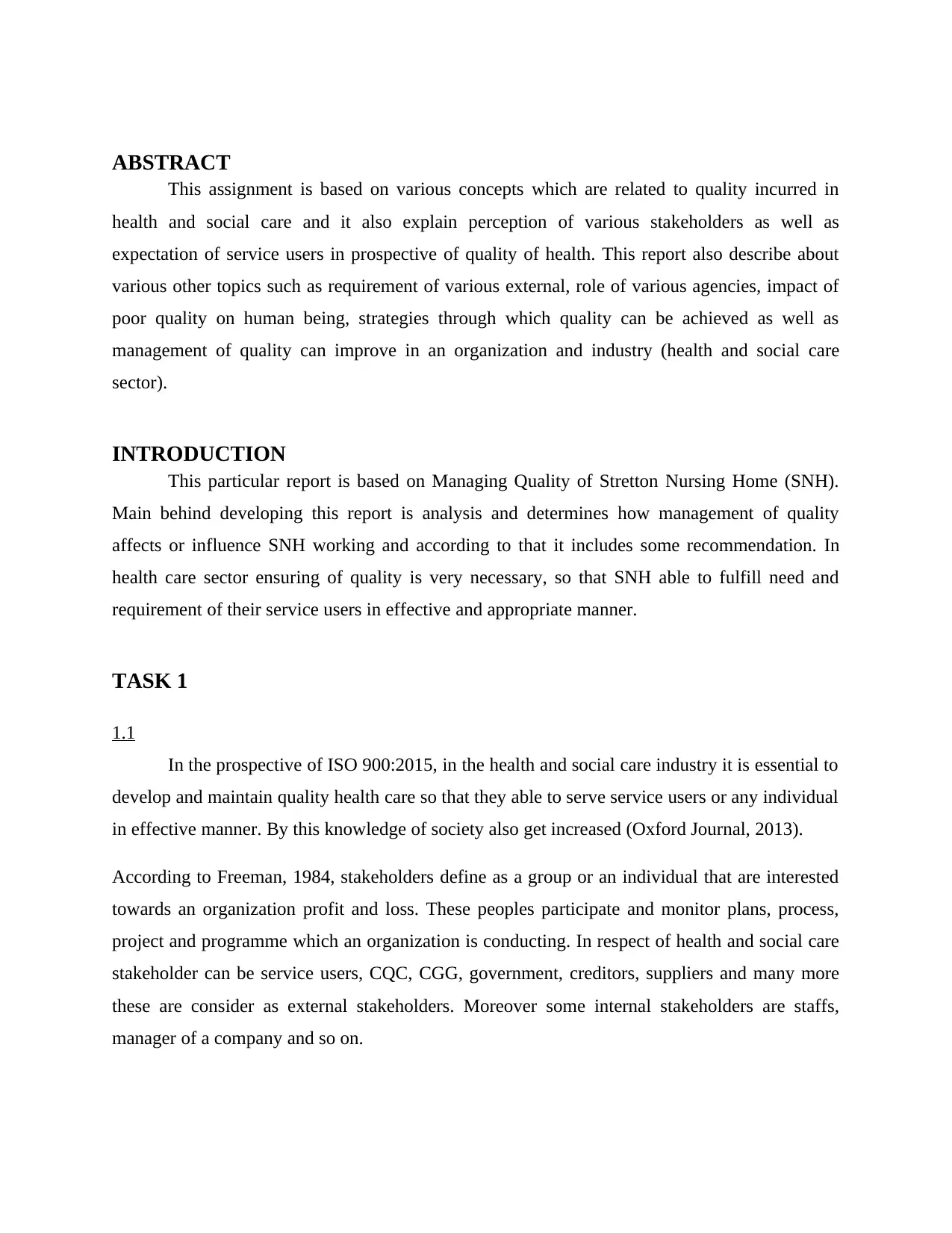
ABSTRACT
This assignment is based on various concepts which are related to quality incurred in
health and social care and it also explain perception of various stakeholders as well as
expectation of service users in prospective of quality of health. This report also describe about
various other topics such as requirement of various external, role of various agencies, impact of
poor quality on human being, strategies through which quality can be achieved as well as
management of quality can improve in an organization and industry (health and social care
sector).
INTRODUCTION
This particular report is based on Managing Quality of Stretton Nursing Home (SNH).
Main behind developing this report is analysis and determines how management of quality
affects or influence SNH working and according to that it includes some recommendation. In
health care sector ensuring of quality is very necessary, so that SNH able to fulfill need and
requirement of their service users in effective and appropriate manner.
TASK 1
1.1
In the prospective of ISO 900:2015, in the health and social care industry it is essential to
develop and maintain quality health care so that they able to serve service users or any individual
in effective manner. By this knowledge of society also get increased (Oxford Journal, 2013).
According to Freeman, 1984, stakeholders define as a group or an individual that are interested
towards an organization profit and loss. These peoples participate and monitor plans, process,
project and programme which an organization is conducting. In respect of health and social care
stakeholder can be service users, CQC, CGG, government, creditors, suppliers and many more
these are consider as external stakeholders. Moreover some internal stakeholders are staffs,
manager of a company and so on.
This assignment is based on various concepts which are related to quality incurred in
health and social care and it also explain perception of various stakeholders as well as
expectation of service users in prospective of quality of health. This report also describe about
various other topics such as requirement of various external, role of various agencies, impact of
poor quality on human being, strategies through which quality can be achieved as well as
management of quality can improve in an organization and industry (health and social care
sector).
INTRODUCTION
This particular report is based on Managing Quality of Stretton Nursing Home (SNH).
Main behind developing this report is analysis and determines how management of quality
affects or influence SNH working and according to that it includes some recommendation. In
health care sector ensuring of quality is very necessary, so that SNH able to fulfill need and
requirement of their service users in effective and appropriate manner.
TASK 1
1.1
In the prospective of ISO 900:2015, in the health and social care industry it is essential to
develop and maintain quality health care so that they able to serve service users or any individual
in effective manner. By this knowledge of society also get increased (Oxford Journal, 2013).
According to Freeman, 1984, stakeholders define as a group or an individual that are interested
towards an organization profit and loss. These peoples participate and monitor plans, process,
project and programme which an organization is conducting. In respect of health and social care
stakeholder can be service users, CQC, CGG, government, creditors, suppliers and many more
these are consider as external stakeholders. Moreover some internal stakeholders are staffs,
manager of a company and so on.
⊘ This is a preview!⊘
Do you want full access?
Subscribe today to unlock all pages.

Trusted by 1+ million students worldwide
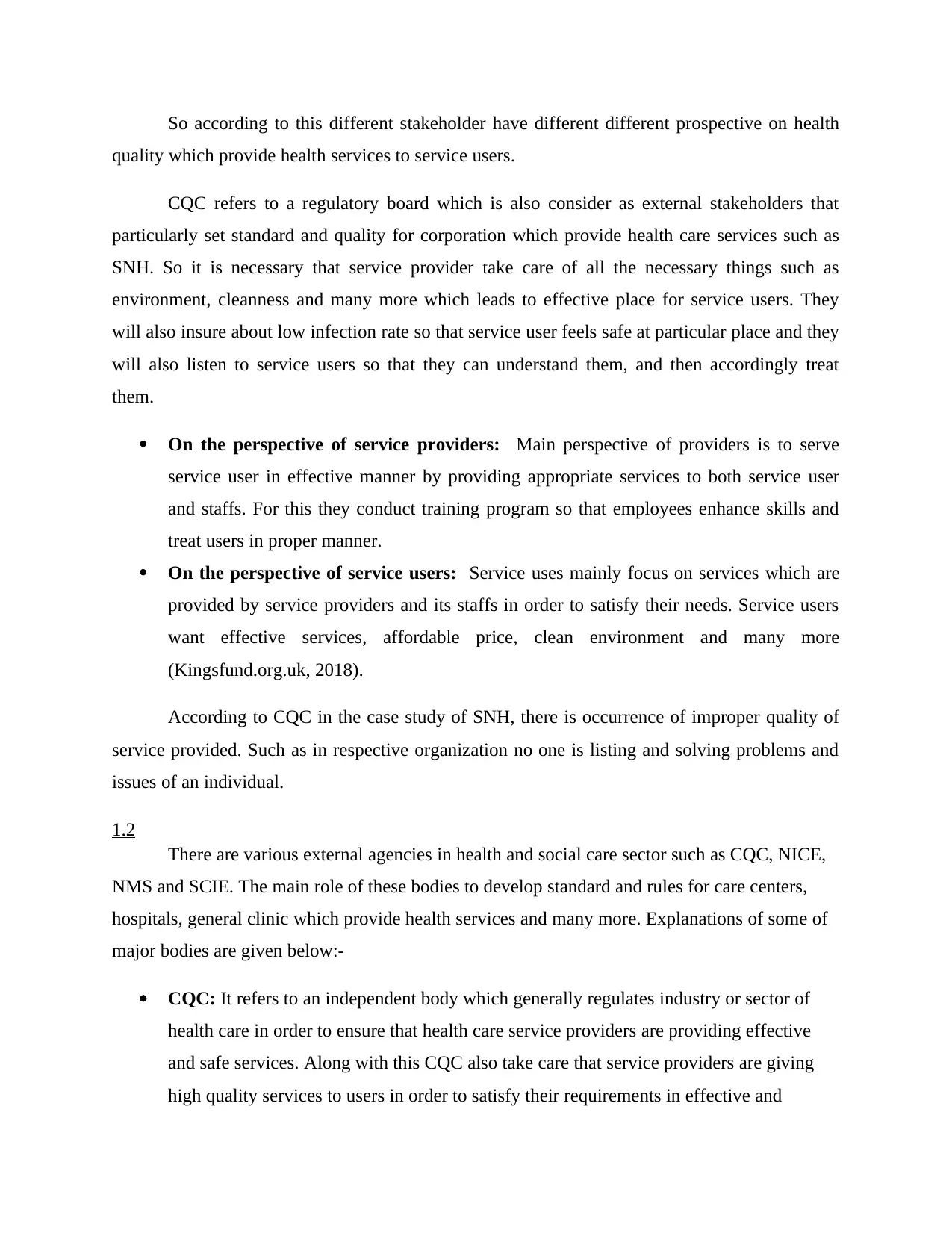
So according to this different stakeholder have different different prospective on health
quality which provide health services to service users.
CQC refers to a regulatory board which is also consider as external stakeholders that
particularly set standard and quality for corporation which provide health care services such as
SNH. So it is necessary that service provider take care of all the necessary things such as
environment, cleanness and many more which leads to effective place for service users. They
will also insure about low infection rate so that service user feels safe at particular place and they
will also listen to service users so that they can understand them, and then accordingly treat
them.
On the perspective of service providers: Main perspective of providers is to serve
service user in effective manner by providing appropriate services to both service user
and staffs. For this they conduct training program so that employees enhance skills and
treat users in proper manner.
On the perspective of service users: Service uses mainly focus on services which are
provided by service providers and its staffs in order to satisfy their needs. Service users
want effective services, affordable price, clean environment and many more
(Kingsfund.org.uk, 2018).
According to CQC in the case study of SNH, there is occurrence of improper quality of
service provided. Such as in respective organization no one is listing and solving problems and
issues of an individual.
1.2
There are various external agencies in health and social care sector such as CQC, NICE,
NMS and SCIE. The main role of these bodies to develop standard and rules for care centers,
hospitals, general clinic which provide health services and many more. Explanations of some of
major bodies are given below:-
CQC: It refers to an independent body which generally regulates industry or sector of
health care in order to ensure that health care service providers are providing effective
and safe services. Along with this CQC also take care that service providers are giving
high quality services to users in order to satisfy their requirements in effective and
quality which provide health services to service users.
CQC refers to a regulatory board which is also consider as external stakeholders that
particularly set standard and quality for corporation which provide health care services such as
SNH. So it is necessary that service provider take care of all the necessary things such as
environment, cleanness and many more which leads to effective place for service users. They
will also insure about low infection rate so that service user feels safe at particular place and they
will also listen to service users so that they can understand them, and then accordingly treat
them.
On the perspective of service providers: Main perspective of providers is to serve
service user in effective manner by providing appropriate services to both service user
and staffs. For this they conduct training program so that employees enhance skills and
treat users in proper manner.
On the perspective of service users: Service uses mainly focus on services which are
provided by service providers and its staffs in order to satisfy their needs. Service users
want effective services, affordable price, clean environment and many more
(Kingsfund.org.uk, 2018).
According to CQC in the case study of SNH, there is occurrence of improper quality of
service provided. Such as in respective organization no one is listing and solving problems and
issues of an individual.
1.2
There are various external agencies in health and social care sector such as CQC, NICE,
NMS and SCIE. The main role of these bodies to develop standard and rules for care centers,
hospitals, general clinic which provide health services and many more. Explanations of some of
major bodies are given below:-
CQC: It refers to an independent body which generally regulates industry or sector of
health care in order to ensure that health care service providers are providing effective
and safe services. Along with this CQC also take care that service providers are giving
high quality services to users in order to satisfy their requirements in effective and
Paraphrase This Document
Need a fresh take? Get an instant paraphrase of this document with our AI Paraphraser
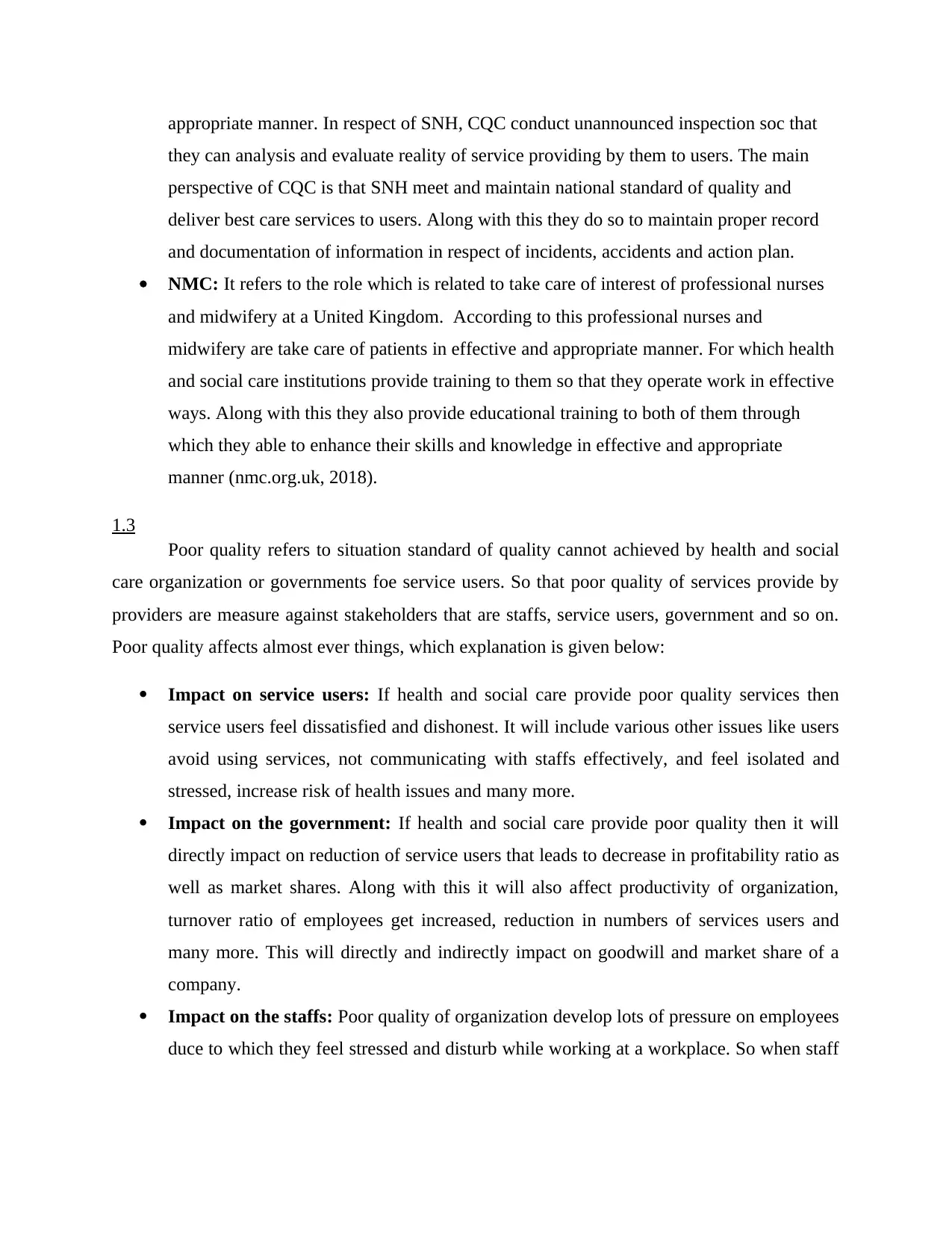
appropriate manner. In respect of SNH, CQC conduct unannounced inspection soc that
they can analysis and evaluate reality of service providing by them to users. The main
perspective of CQC is that SNH meet and maintain national standard of quality and
deliver best care services to users. Along with this they do so to maintain proper record
and documentation of information in respect of incidents, accidents and action plan.
NMC: It refers to the role which is related to take care of interest of professional nurses
and midwifery at a United Kingdom. According to this professional nurses and
midwifery are take care of patients in effective and appropriate manner. For which health
and social care institutions provide training to them so that they operate work in effective
ways. Along with this they also provide educational training to both of them through
which they able to enhance their skills and knowledge in effective and appropriate
manner (nmc.org.uk, 2018).
1.3
Poor quality refers to situation standard of quality cannot achieved by health and social
care organization or governments foe service users. So that poor quality of services provide by
providers are measure against stakeholders that are staffs, service users, government and so on.
Poor quality affects almost ever things, which explanation is given below:
Impact on service users: If health and social care provide poor quality services then
service users feel dissatisfied and dishonest. It will include various other issues like users
avoid using services, not communicating with staffs effectively, and feel isolated and
stressed, increase risk of health issues and many more.
Impact on the government: If health and social care provide poor quality then it will
directly impact on reduction of service users that leads to decrease in profitability ratio as
well as market shares. Along with this it will also affect productivity of organization,
turnover ratio of employees get increased, reduction in numbers of services users and
many more. This will directly and indirectly impact on goodwill and market share of a
company.
Impact on the staffs: Poor quality of organization develop lots of pressure on employees
duce to which they feel stressed and disturb while working at a workplace. So when staff
they can analysis and evaluate reality of service providing by them to users. The main
perspective of CQC is that SNH meet and maintain national standard of quality and
deliver best care services to users. Along with this they do so to maintain proper record
and documentation of information in respect of incidents, accidents and action plan.
NMC: It refers to the role which is related to take care of interest of professional nurses
and midwifery at a United Kingdom. According to this professional nurses and
midwifery are take care of patients in effective and appropriate manner. For which health
and social care institutions provide training to them so that they operate work in effective
ways. Along with this they also provide educational training to both of them through
which they able to enhance their skills and knowledge in effective and appropriate
manner (nmc.org.uk, 2018).
1.3
Poor quality refers to situation standard of quality cannot achieved by health and social
care organization or governments foe service users. So that poor quality of services provide by
providers are measure against stakeholders that are staffs, service users, government and so on.
Poor quality affects almost ever things, which explanation is given below:
Impact on service users: If health and social care provide poor quality services then
service users feel dissatisfied and dishonest. It will include various other issues like users
avoid using services, not communicating with staffs effectively, and feel isolated and
stressed, increase risk of health issues and many more.
Impact on the government: If health and social care provide poor quality then it will
directly impact on reduction of service users that leads to decrease in profitability ratio as
well as market shares. Along with this it will also affect productivity of organization,
turnover ratio of employees get increased, reduction in numbers of services users and
many more. This will directly and indirectly impact on goodwill and market share of a
company.
Impact on the staffs: Poor quality of organization develop lots of pressure on employees
duce to which they feel stressed and disturb while working at a workplace. So when staff
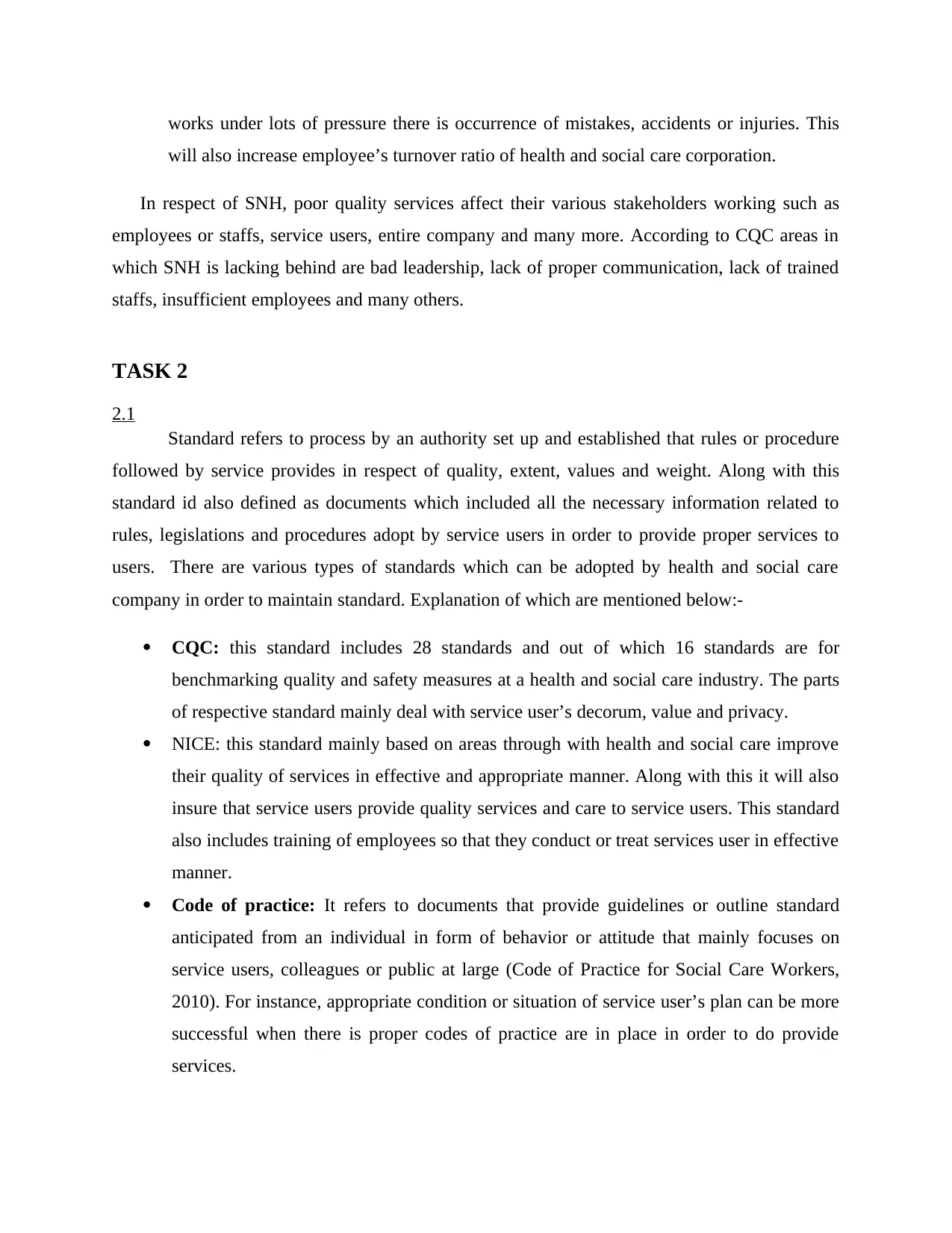
works under lots of pressure there is occurrence of mistakes, accidents or injuries. This
will also increase employee’s turnover ratio of health and social care corporation.
In respect of SNH, poor quality services affect their various stakeholders working such as
employees or staffs, service users, entire company and many more. According to CQC areas in
which SNH is lacking behind are bad leadership, lack of proper communication, lack of trained
staffs, insufficient employees and many others.
TASK 2
2.1
Standard refers to process by an authority set up and established that rules or procedure
followed by service provides in respect of quality, extent, values and weight. Along with this
standard id also defined as documents which included all the necessary information related to
rules, legislations and procedures adopt by service users in order to provide proper services to
users. There are various types of standards which can be adopted by health and social care
company in order to maintain standard. Explanation of which are mentioned below:-
CQC: this standard includes 28 standards and out of which 16 standards are for
benchmarking quality and safety measures at a health and social care industry. The parts
of respective standard mainly deal with service user’s decorum, value and privacy.
NICE: this standard mainly based on areas through with health and social care improve
their quality of services in effective and appropriate manner. Along with this it will also
insure that service users provide quality services and care to service users. This standard
also includes training of employees so that they conduct or treat services user in effective
manner.
Code of practice: It refers to documents that provide guidelines or outline standard
anticipated from an individual in form of behavior or attitude that mainly focuses on
service users, colleagues or public at large (Code of Practice for Social Care Workers,
2010). For instance, appropriate condition or situation of service user’s plan can be more
successful when there is proper codes of practice are in place in order to do provide
services.
will also increase employee’s turnover ratio of health and social care corporation.
In respect of SNH, poor quality services affect their various stakeholders working such as
employees or staffs, service users, entire company and many more. According to CQC areas in
which SNH is lacking behind are bad leadership, lack of proper communication, lack of trained
staffs, insufficient employees and many others.
TASK 2
2.1
Standard refers to process by an authority set up and established that rules or procedure
followed by service provides in respect of quality, extent, values and weight. Along with this
standard id also defined as documents which included all the necessary information related to
rules, legislations and procedures adopt by service users in order to provide proper services to
users. There are various types of standards which can be adopted by health and social care
company in order to maintain standard. Explanation of which are mentioned below:-
CQC: this standard includes 28 standards and out of which 16 standards are for
benchmarking quality and safety measures at a health and social care industry. The parts
of respective standard mainly deal with service user’s decorum, value and privacy.
NICE: this standard mainly based on areas through with health and social care improve
their quality of services in effective and appropriate manner. Along with this it will also
insure that service users provide quality services and care to service users. This standard
also includes training of employees so that they conduct or treat services user in effective
manner.
Code of practice: It refers to documents that provide guidelines or outline standard
anticipated from an individual in form of behavior or attitude that mainly focuses on
service users, colleagues or public at large (Code of Practice for Social Care Workers,
2010). For instance, appropriate condition or situation of service user’s plan can be more
successful when there is proper codes of practice are in place in order to do provide
services.
⊘ This is a preview!⊘
Do you want full access?
Subscribe today to unlock all pages.

Trusted by 1+ million students worldwide
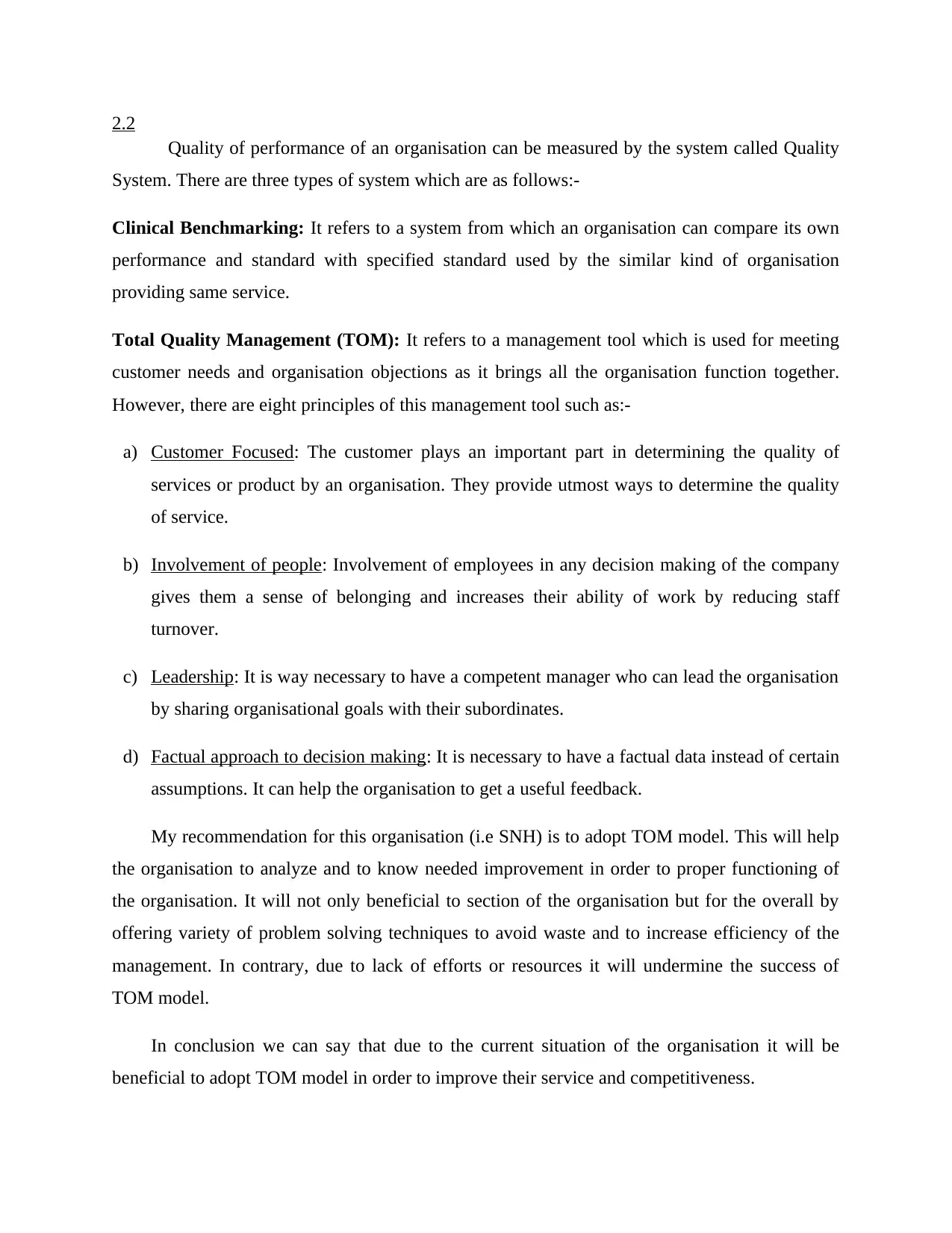
2.2
Quality of performance of an organisation can be measured by the system called Quality
System. There are three types of system which are as follows:-
Clinical Benchmarking: It refers to a system from which an organisation can compare its own
performance and standard with specified standard used by the similar kind of organisation
providing same service.
Total Quality Management (TOM): It refers to a management tool which is used for meeting
customer needs and organisation objections as it brings all the organisation function together.
However, there are eight principles of this management tool such as:-
a) Customer Focused: The customer plays an important part in determining the quality of
services or product by an organisation. They provide utmost ways to determine the quality
of service.
b) Involvement of people: Involvement of employees in any decision making of the company
gives them a sense of belonging and increases their ability of work by reducing staff
turnover.
c) Leadership: It is way necessary to have a competent manager who can lead the organisation
by sharing organisational goals with their subordinates.
d) Factual approach to decision making: It is necessary to have a factual data instead of certain
assumptions. It can help the organisation to get a useful feedback.
My recommendation for this organisation (i.e SNH) is to adopt TOM model. This will help
the organisation to analyze and to know needed improvement in order to proper functioning of
the organisation. It will not only beneficial to section of the organisation but for the overall by
offering variety of problem solving techniques to avoid waste and to increase efficiency of the
management. In contrary, due to lack of efforts or resources it will undermine the success of
TOM model.
In conclusion we can say that due to the current situation of the organisation it will be
beneficial to adopt TOM model in order to improve their service and competitiveness.
Quality of performance of an organisation can be measured by the system called Quality
System. There are three types of system which are as follows:-
Clinical Benchmarking: It refers to a system from which an organisation can compare its own
performance and standard with specified standard used by the similar kind of organisation
providing same service.
Total Quality Management (TOM): It refers to a management tool which is used for meeting
customer needs and organisation objections as it brings all the organisation function together.
However, there are eight principles of this management tool such as:-
a) Customer Focused: The customer plays an important part in determining the quality of
services or product by an organisation. They provide utmost ways to determine the quality
of service.
b) Involvement of people: Involvement of employees in any decision making of the company
gives them a sense of belonging and increases their ability of work by reducing staff
turnover.
c) Leadership: It is way necessary to have a competent manager who can lead the organisation
by sharing organisational goals with their subordinates.
d) Factual approach to decision making: It is necessary to have a factual data instead of certain
assumptions. It can help the organisation to get a useful feedback.
My recommendation for this organisation (i.e SNH) is to adopt TOM model. This will help
the organisation to analyze and to know needed improvement in order to proper functioning of
the organisation. It will not only beneficial to section of the organisation but for the overall by
offering variety of problem solving techniques to avoid waste and to increase efficiency of the
management. In contrary, due to lack of efforts or resources it will undermine the success of
TOM model.
In conclusion we can say that due to the current situation of the organisation it will be
beneficial to adopt TOM model in order to improve their service and competitiveness.
Paraphrase This Document
Need a fresh take? Get an instant paraphrase of this document with our AI Paraphraser
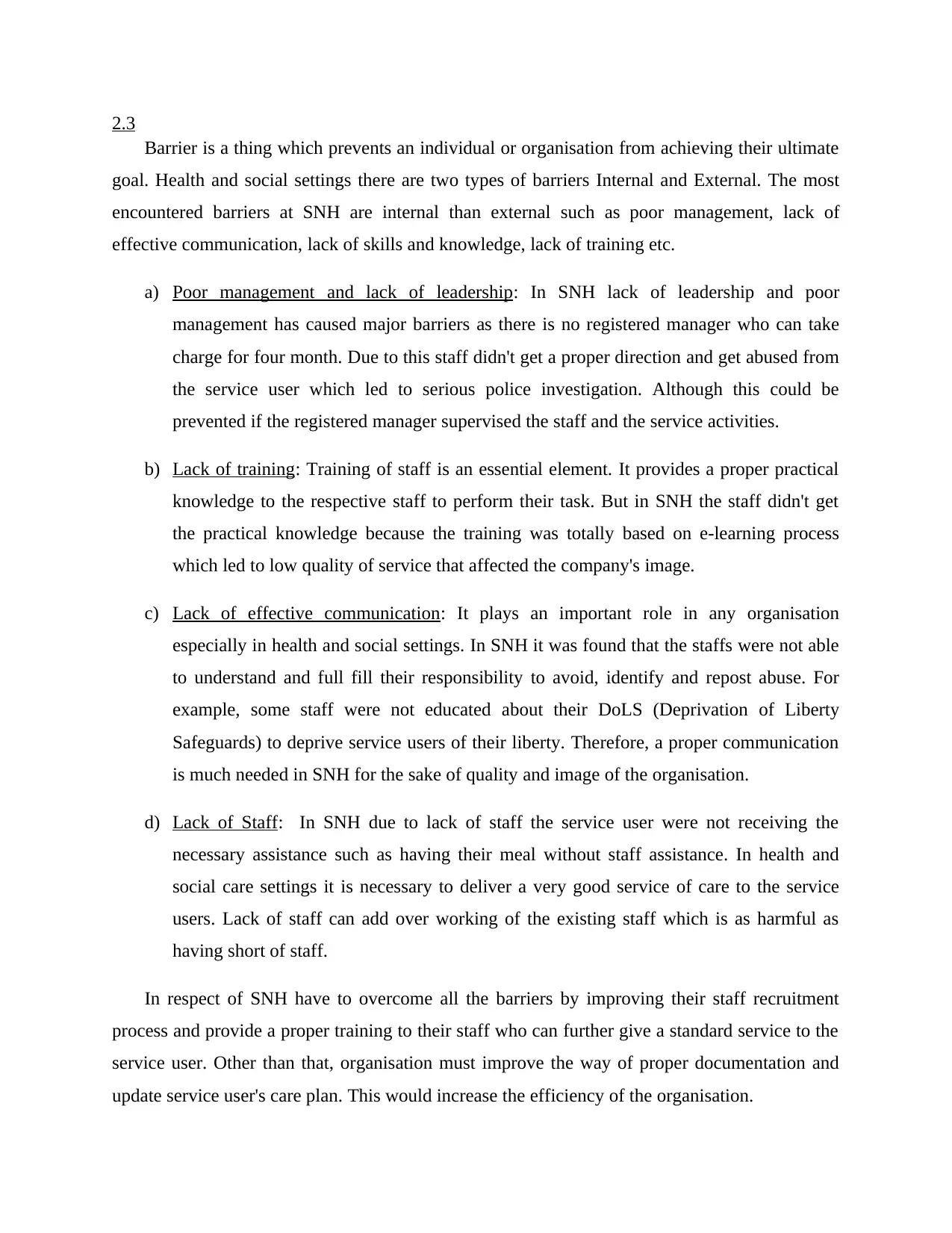
2.3
Barrier is a thing which prevents an individual or organisation from achieving their ultimate
goal. Health and social settings there are two types of barriers Internal and External. The most
encountered barriers at SNH are internal than external such as poor management, lack of
effective communication, lack of skills and knowledge, lack of training etc.
a) Poor management and lack of leadership: In SNH lack of leadership and poor
management has caused major barriers as there is no registered manager who can take
charge for four month. Due to this staff didn't get a proper direction and get abused from
the service user which led to serious police investigation. Although this could be
prevented if the registered manager supervised the staff and the service activities.
b) Lack of training: Training of staff is an essential element. It provides a proper practical
knowledge to the respective staff to perform their task. But in SNH the staff didn't get
the practical knowledge because the training was totally based on e-learning process
which led to low quality of service that affected the company's image.
c) Lack of effective communication: It plays an important role in any organisation
especially in health and social settings. In SNH it was found that the staffs were not able
to understand and full fill their responsibility to avoid, identify and repost abuse. For
example, some staff were not educated about their DoLS (Deprivation of Liberty
Safeguards) to deprive service users of their liberty. Therefore, a proper communication
is much needed in SNH for the sake of quality and image of the organisation.
d) Lack of Staff: In SNH due to lack of staff the service user were not receiving the
necessary assistance such as having their meal without staff assistance. In health and
social care settings it is necessary to deliver a very good service of care to the service
users. Lack of staff can add over working of the existing staff which is as harmful as
having short of staff.
In respect of SNH have to overcome all the barriers by improving their staff recruitment
process and provide a proper training to their staff who can further give a standard service to the
service user. Other than that, organisation must improve the way of proper documentation and
update service user's care plan. This would increase the efficiency of the organisation.
Barrier is a thing which prevents an individual or organisation from achieving their ultimate
goal. Health and social settings there are two types of barriers Internal and External. The most
encountered barriers at SNH are internal than external such as poor management, lack of
effective communication, lack of skills and knowledge, lack of training etc.
a) Poor management and lack of leadership: In SNH lack of leadership and poor
management has caused major barriers as there is no registered manager who can take
charge for four month. Due to this staff didn't get a proper direction and get abused from
the service user which led to serious police investigation. Although this could be
prevented if the registered manager supervised the staff and the service activities.
b) Lack of training: Training of staff is an essential element. It provides a proper practical
knowledge to the respective staff to perform their task. But in SNH the staff didn't get
the practical knowledge because the training was totally based on e-learning process
which led to low quality of service that affected the company's image.
c) Lack of effective communication: It plays an important role in any organisation
especially in health and social settings. In SNH it was found that the staffs were not able
to understand and full fill their responsibility to avoid, identify and repost abuse. For
example, some staff were not educated about their DoLS (Deprivation of Liberty
Safeguards) to deprive service users of their liberty. Therefore, a proper communication
is much needed in SNH for the sake of quality and image of the organisation.
d) Lack of Staff: In SNH due to lack of staff the service user were not receiving the
necessary assistance such as having their meal without staff assistance. In health and
social care settings it is necessary to deliver a very good service of care to the service
users. Lack of staff can add over working of the existing staff which is as harmful as
having short of staff.
In respect of SNH have to overcome all the barriers by improving their staff recruitment
process and provide a proper training to their staff who can further give a standard service to the
service user. Other than that, organisation must improve the way of proper documentation and
update service user's care plan. This would increase the efficiency of the organisation.
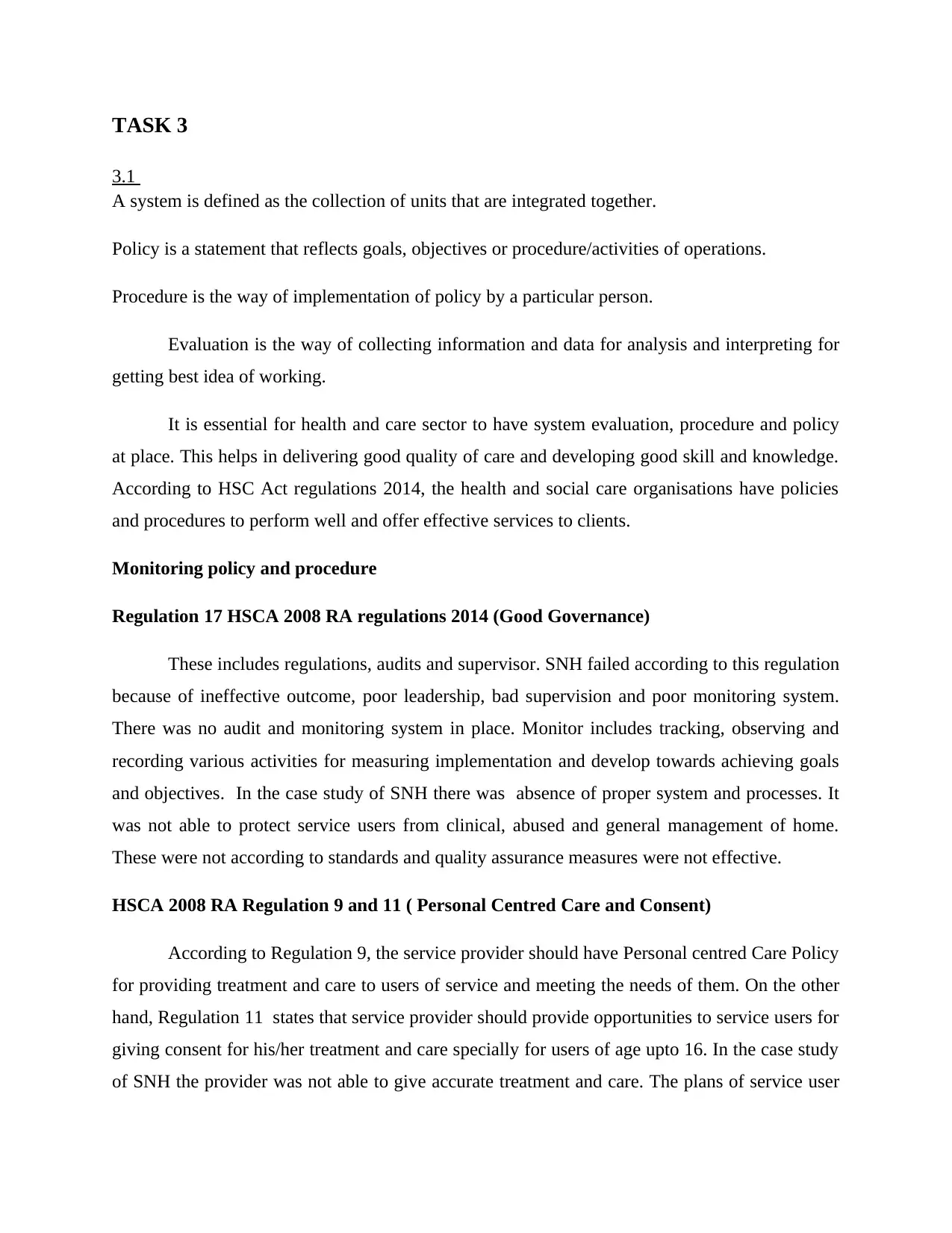
TASK 3
3.1
A system is defined as the collection of units that are integrated together.
Policy is a statement that reflects goals, objectives or procedure/activities of operations.
Procedure is the way of implementation of policy by a particular person.
Evaluation is the way of collecting information and data for analysis and interpreting for
getting best idea of working.
It is essential for health and care sector to have system evaluation, procedure and policy
at place. This helps in delivering good quality of care and developing good skill and knowledge.
According to HSC Act regulations 2014, the health and social care organisations have policies
and procedures to perform well and offer effective services to clients.
Monitoring policy and procedure
Regulation 17 HSCA 2008 RA regulations 2014 (Good Governance)
These includes regulations, audits and supervisor. SNH failed according to this regulation
because of ineffective outcome, poor leadership, bad supervision and poor monitoring system.
There was no audit and monitoring system in place. Monitor includes tracking, observing and
recording various activities for measuring implementation and develop towards achieving goals
and objectives. In the case study of SNH there was absence of proper system and processes. It
was not able to protect service users from clinical, abused and general management of home.
These were not according to standards and quality assurance measures were not effective.
HSCA 2008 RA Regulation 9 and 11 ( Personal Centred Care and Consent)
According to Regulation 9, the service provider should have Personal centred Care Policy
for providing treatment and care to users of service and meeting the needs of them. On the other
hand, Regulation 11 states that service provider should provide opportunities to service users for
giving consent for his/her treatment and care specially for users of age upto 16. In the case study
of SNH the provider was not able to give accurate treatment and care. The plans of service user
3.1
A system is defined as the collection of units that are integrated together.
Policy is a statement that reflects goals, objectives or procedure/activities of operations.
Procedure is the way of implementation of policy by a particular person.
Evaluation is the way of collecting information and data for analysis and interpreting for
getting best idea of working.
It is essential for health and care sector to have system evaluation, procedure and policy
at place. This helps in delivering good quality of care and developing good skill and knowledge.
According to HSC Act regulations 2014, the health and social care organisations have policies
and procedures to perform well and offer effective services to clients.
Monitoring policy and procedure
Regulation 17 HSCA 2008 RA regulations 2014 (Good Governance)
These includes regulations, audits and supervisor. SNH failed according to this regulation
because of ineffective outcome, poor leadership, bad supervision and poor monitoring system.
There was no audit and monitoring system in place. Monitor includes tracking, observing and
recording various activities for measuring implementation and develop towards achieving goals
and objectives. In the case study of SNH there was absence of proper system and processes. It
was not able to protect service users from clinical, abused and general management of home.
These were not according to standards and quality assurance measures were not effective.
HSCA 2008 RA Regulation 9 and 11 ( Personal Centred Care and Consent)
According to Regulation 9, the service provider should have Personal centred Care Policy
for providing treatment and care to users of service and meeting the needs of them. On the other
hand, Regulation 11 states that service provider should provide opportunities to service users for
giving consent for his/her treatment and care specially for users of age upto 16. In the case study
of SNH the provider was not able to give accurate treatment and care. The plans of service user
⊘ This is a preview!⊘
Do you want full access?
Subscribe today to unlock all pages.

Trusted by 1+ million students worldwide
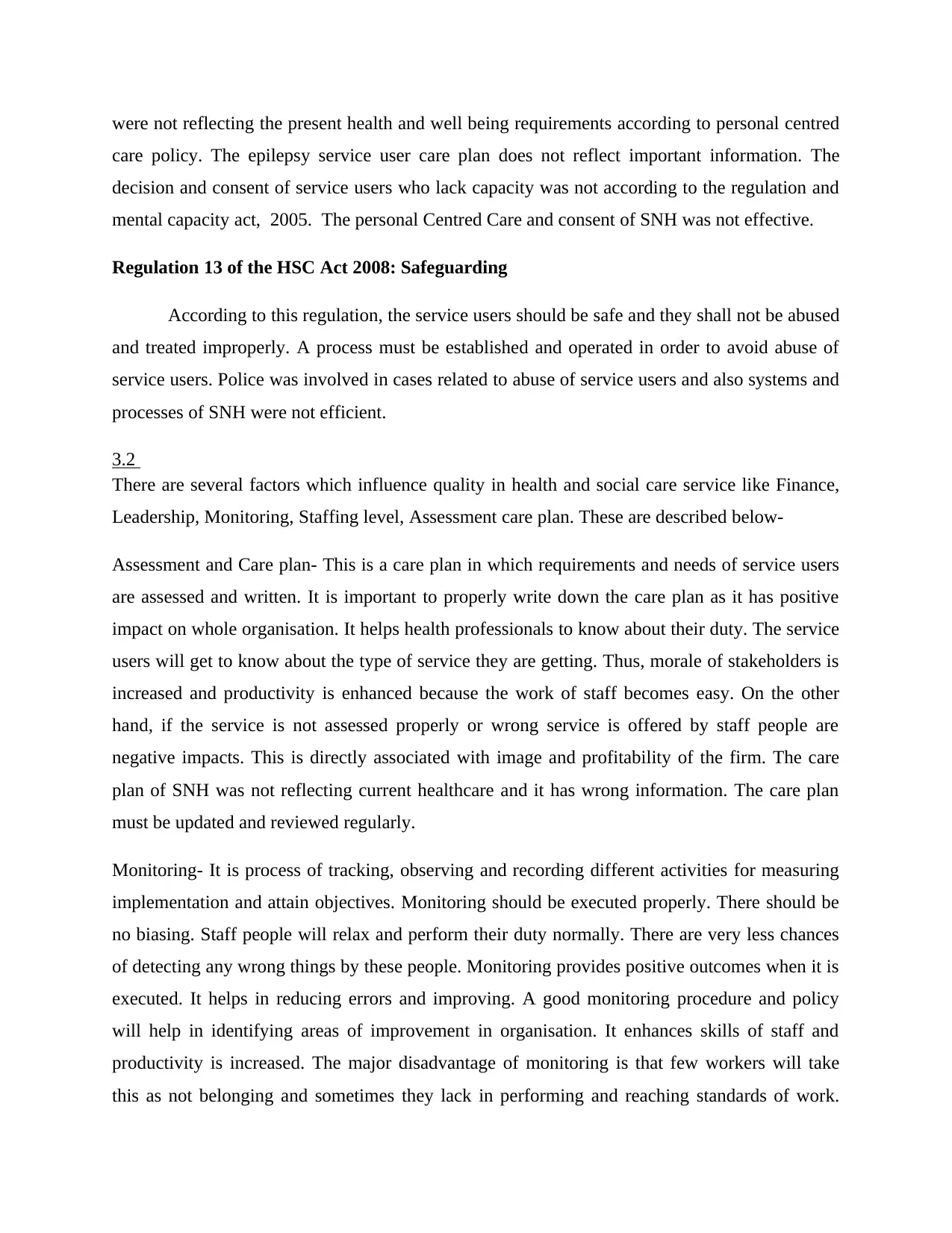
were not reflecting the present health and well being requirements according to personal centred
care policy. The epilepsy service user care plan does not reflect important information. The
decision and consent of service users who lack capacity was not according to the regulation and
mental capacity act, 2005. The personal Centred Care and consent of SNH was not effective.
Regulation 13 of the HSC Act 2008: Safeguarding
According to this regulation, the service users should be safe and they shall not be abused
and treated improperly. A process must be established and operated in order to avoid abuse of
service users. Police was involved in cases related to abuse of service users and also systems and
processes of SNH were not efficient.
3.2
There are several factors which influence quality in health and social care service like Finance,
Leadership, Monitoring, Staffing level, Assessment care plan. These are described below-
Assessment and Care plan- This is a care plan in which requirements and needs of service users
are assessed and written. It is important to properly write down the care plan as it has positive
impact on whole organisation. It helps health professionals to know about their duty. The service
users will get to know about the type of service they are getting. Thus, morale of stakeholders is
increased and productivity is enhanced because the work of staff becomes easy. On the other
hand, if the service is not assessed properly or wrong service is offered by staff people are
negative impacts. This is directly associated with image and profitability of the firm. The care
plan of SNH was not reflecting current healthcare and it has wrong information. The care plan
must be updated and reviewed regularly.
Monitoring- It is process of tracking, observing and recording different activities for measuring
implementation and attain objectives. Monitoring should be executed properly. There should be
no biasing. Staff people will relax and perform their duty normally. There are very less chances
of detecting any wrong things by these people. Monitoring provides positive outcomes when it is
executed. It helps in reducing errors and improving. A good monitoring procedure and policy
will help in identifying areas of improvement in organisation. It enhances skills of staff and
productivity is increased. The major disadvantage of monitoring is that few workers will take
this as not belonging and sometimes they lack in performing and reaching standards of work.
care policy. The epilepsy service user care plan does not reflect important information. The
decision and consent of service users who lack capacity was not according to the regulation and
mental capacity act, 2005. The personal Centred Care and consent of SNH was not effective.
Regulation 13 of the HSC Act 2008: Safeguarding
According to this regulation, the service users should be safe and they shall not be abused
and treated improperly. A process must be established and operated in order to avoid abuse of
service users. Police was involved in cases related to abuse of service users and also systems and
processes of SNH were not efficient.
3.2
There are several factors which influence quality in health and social care service like Finance,
Leadership, Monitoring, Staffing level, Assessment care plan. These are described below-
Assessment and Care plan- This is a care plan in which requirements and needs of service users
are assessed and written. It is important to properly write down the care plan as it has positive
impact on whole organisation. It helps health professionals to know about their duty. The service
users will get to know about the type of service they are getting. Thus, morale of stakeholders is
increased and productivity is enhanced because the work of staff becomes easy. On the other
hand, if the service is not assessed properly or wrong service is offered by staff people are
negative impacts. This is directly associated with image and profitability of the firm. The care
plan of SNH was not reflecting current healthcare and it has wrong information. The care plan
must be updated and reviewed regularly.
Monitoring- It is process of tracking, observing and recording different activities for measuring
implementation and attain objectives. Monitoring should be executed properly. There should be
no biasing. Staff people will relax and perform their duty normally. There are very less chances
of detecting any wrong things by these people. Monitoring provides positive outcomes when it is
executed. It helps in reducing errors and improving. A good monitoring procedure and policy
will help in identifying areas of improvement in organisation. It enhances skills of staff and
productivity is increased. The major disadvantage of monitoring is that few workers will take
this as not belonging and sometimes they lack in performing and reaching standards of work.
Paraphrase This Document
Need a fresh take? Get an instant paraphrase of this document with our AI Paraphraser
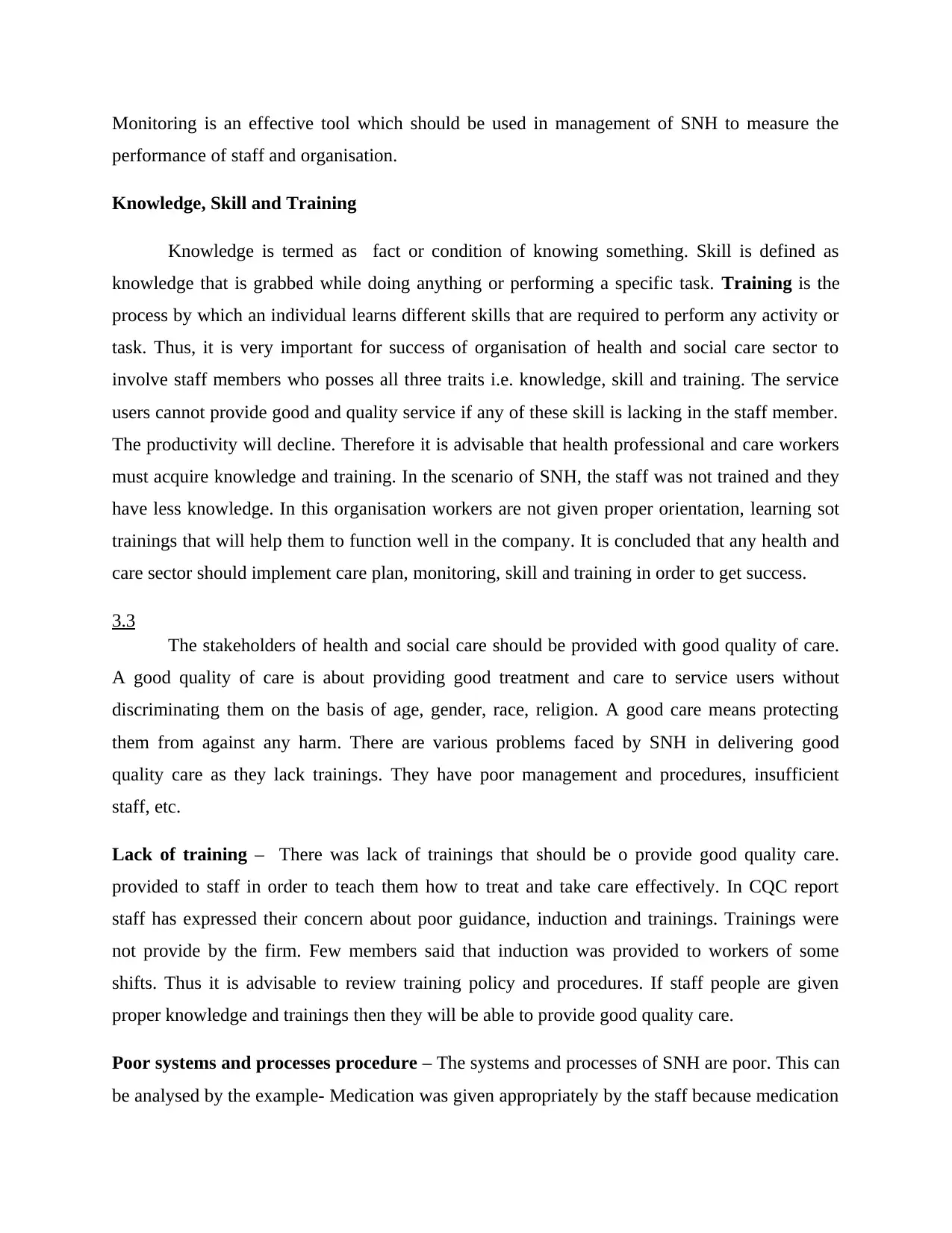
Monitoring is an effective tool which should be used in management of SNH to measure the
performance of staff and organisation.
Knowledge, Skill and Training
Knowledge is termed as fact or condition of knowing something. Skill is defined as
knowledge that is grabbed while doing anything or performing a specific task. Training is the
process by which an individual learns different skills that are required to perform any activity or
task. Thus, it is very important for success of organisation of health and social care sector to
involve staff members who posses all three traits i.e. knowledge, skill and training. The service
users cannot provide good and quality service if any of these skill is lacking in the staff member.
The productivity will decline. Therefore it is advisable that health professional and care workers
must acquire knowledge and training. In the scenario of SNH, the staff was not trained and they
have less knowledge. In this organisation workers are not given proper orientation, learning sot
trainings that will help them to function well in the company. It is concluded that any health and
care sector should implement care plan, monitoring, skill and training in order to get success.
3.3
The stakeholders of health and social care should be provided with good quality of care.
A good quality of care is about providing good treatment and care to service users without
discriminating them on the basis of age, gender, race, religion. A good care means protecting
them from against any harm. There are various problems faced by SNH in delivering good
quality care as they lack trainings. They have poor management and procedures, insufficient
staff, etc.
Lack of training – There was lack of trainings that should be o provide good quality care.
provided to staff in order to teach them how to treat and take care effectively. In CQC report
staff has expressed their concern about poor guidance, induction and trainings. Trainings were
not provide by the firm. Few members said that induction was provided to workers of some
shifts. Thus it is advisable to review training policy and procedures. If staff people are given
proper knowledge and trainings then they will be able to provide good quality care.
Poor systems and processes procedure – The systems and processes of SNH are poor. This can
be analysed by the example- Medication was given appropriately by the staff because medication
performance of staff and organisation.
Knowledge, Skill and Training
Knowledge is termed as fact or condition of knowing something. Skill is defined as
knowledge that is grabbed while doing anything or performing a specific task. Training is the
process by which an individual learns different skills that are required to perform any activity or
task. Thus, it is very important for success of organisation of health and social care sector to
involve staff members who posses all three traits i.e. knowledge, skill and training. The service
users cannot provide good and quality service if any of these skill is lacking in the staff member.
The productivity will decline. Therefore it is advisable that health professional and care workers
must acquire knowledge and training. In the scenario of SNH, the staff was not trained and they
have less knowledge. In this organisation workers are not given proper orientation, learning sot
trainings that will help them to function well in the company. It is concluded that any health and
care sector should implement care plan, monitoring, skill and training in order to get success.
3.3
The stakeholders of health and social care should be provided with good quality of care.
A good quality of care is about providing good treatment and care to service users without
discriminating them on the basis of age, gender, race, religion. A good care means protecting
them from against any harm. There are various problems faced by SNH in delivering good
quality care as they lack trainings. They have poor management and procedures, insufficient
staff, etc.
Lack of training – There was lack of trainings that should be o provide good quality care.
provided to staff in order to teach them how to treat and take care effectively. In CQC report
staff has expressed their concern about poor guidance, induction and trainings. Trainings were
not provide by the firm. Few members said that induction was provided to workers of some
shifts. Thus it is advisable to review training policy and procedures. If staff people are given
proper knowledge and trainings then they will be able to provide good quality care.
Poor systems and processes procedure – The systems and processes of SNH are poor. This can
be analysed by the example- Medication was given appropriately by the staff because medication
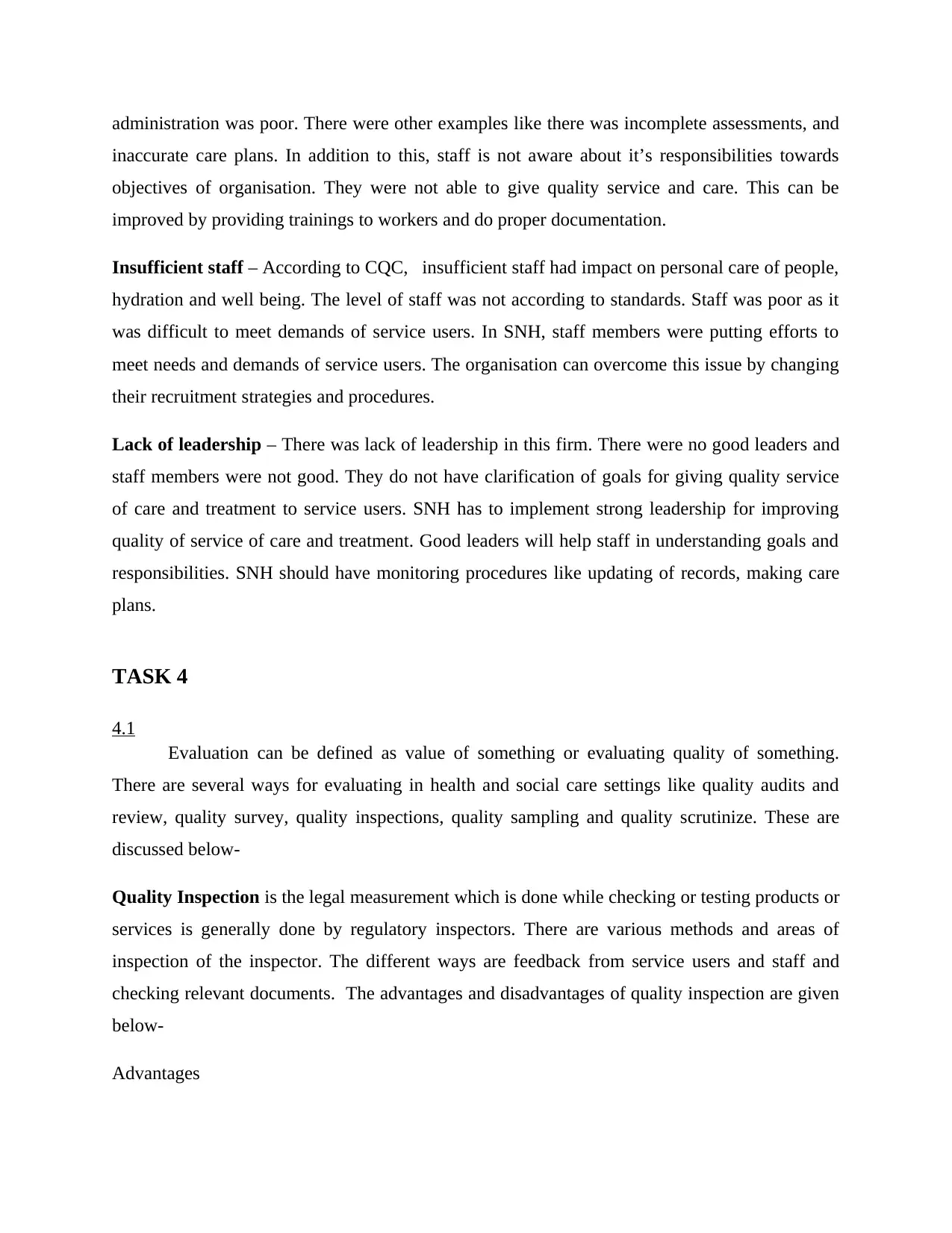
administration was poor. There were other examples like there was incomplete assessments, and
inaccurate care plans. In addition to this, staff is not aware about it’s responsibilities towards
objectives of organisation. They were not able to give quality service and care. This can be
improved by providing trainings to workers and do proper documentation.
Insufficient staff – According to CQC, insufficient staff had impact on personal care of people,
hydration and well being. The level of staff was not according to standards. Staff was poor as it
was difficult to meet demands of service users. In SNH, staff members were putting efforts to
meet needs and demands of service users. The organisation can overcome this issue by changing
their recruitment strategies and procedures.
Lack of leadership – There was lack of leadership in this firm. There were no good leaders and
staff members were not good. They do not have clarification of goals for giving quality service
of care and treatment to service users. SNH has to implement strong leadership for improving
quality of service of care and treatment. Good leaders will help staff in understanding goals and
responsibilities. SNH should have monitoring procedures like updating of records, making care
plans.
TASK 4
4.1
Evaluation can be defined as value of something or evaluating quality of something.
There are several ways for evaluating in health and social care settings like quality audits and
review, quality survey, quality inspections, quality sampling and quality scrutinize. These are
discussed below-
Quality Inspection is the legal measurement which is done while checking or testing products or
services is generally done by regulatory inspectors. There are various methods and areas of
inspection of the inspector. The different ways are feedback from service users and staff and
checking relevant documents. The advantages and disadvantages of quality inspection are given
below-
Advantages
inaccurate care plans. In addition to this, staff is not aware about it’s responsibilities towards
objectives of organisation. They were not able to give quality service and care. This can be
improved by providing trainings to workers and do proper documentation.
Insufficient staff – According to CQC, insufficient staff had impact on personal care of people,
hydration and well being. The level of staff was not according to standards. Staff was poor as it
was difficult to meet demands of service users. In SNH, staff members were putting efforts to
meet needs and demands of service users. The organisation can overcome this issue by changing
their recruitment strategies and procedures.
Lack of leadership – There was lack of leadership in this firm. There were no good leaders and
staff members were not good. They do not have clarification of goals for giving quality service
of care and treatment to service users. SNH has to implement strong leadership for improving
quality of service of care and treatment. Good leaders will help staff in understanding goals and
responsibilities. SNH should have monitoring procedures like updating of records, making care
plans.
TASK 4
4.1
Evaluation can be defined as value of something or evaluating quality of something.
There are several ways for evaluating in health and social care settings like quality audits and
review, quality survey, quality inspections, quality sampling and quality scrutinize. These are
discussed below-
Quality Inspection is the legal measurement which is done while checking or testing products or
services is generally done by regulatory inspectors. There are various methods and areas of
inspection of the inspector. The different ways are feedback from service users and staff and
checking relevant documents. The advantages and disadvantages of quality inspection are given
below-
Advantages
⊘ This is a preview!⊘
Do you want full access?
Subscribe today to unlock all pages.

Trusted by 1+ million students worldwide
1 out of 15
Related Documents
Your All-in-One AI-Powered Toolkit for Academic Success.
+13062052269
info@desklib.com
Available 24*7 on WhatsApp / Email
![[object Object]](/_next/static/media/star-bottom.7253800d.svg)
Unlock your academic potential
Copyright © 2020–2025 A2Z Services. All Rights Reserved. Developed and managed by ZUCOL.





